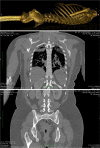Atypical wound trajectory after a tangential pistol shot
- PMID: 36355085
- PMCID: PMC9902430
- DOI: 10.1007/s00414-022-02905-y
Atypical wound trajectory after a tangential pistol shot
Abstract
Three intermediate-range shots from a Browning, model 1955, 7.65 mm caliber, pistol were fired from the driver's seat of a car at a woman in the passenger seat. She sustained three wounds: An, ultimately fatal, penetrating head wound, a graze wound across her forehead, and a tangential, perforating, wound, with bullet entry over the medial sternum and exit through the right flank. Neither postmortem CT nor forensic autopsy discovered bony thoracic injuries or perforations of the thoracoabdominal cavities. There was pulmonary contusion in the medial lobe of the right lung and hemorrhage in the adipose tissue around the right kidney. The tangential bullet had left an almost 40-cm-long wound channel through a pronounced layer of subcutaneous fat. Based on 3D reconstructed CT-data determinations, a straight bullet trajectory between entry and exit wounds would have traversed the abdominothoracic cavities, right lung, and liver. The actual trajectory, however, described a prominent curve, without signs of deflection by bone. Postulated explanations for this unusual bullet track are that the woman was twisting her body in a dynamic scene when the bullet struck; further, due to its shallow angle of incidence on the skin, the bullet was deflected to an intracutaneous path. Additionally, soft tissue resistance may have caused the bullet to yaw. Caution should, thus, be exercised when reconstructing bullet trajectories solely from entry and exist wounds, also for bullet wounds through basically homogenous soft tissues.
Keywords: Autopsy; Bullet trajectory deflection; Gunshot; Murder; Post-mortem CT.
© 2022. The Author(s).
Conflict of interest statement
The authors declare no competing interests.
Figures







References
MeSH terms
LinkOut - more resources
Full Text Sources
Medical

